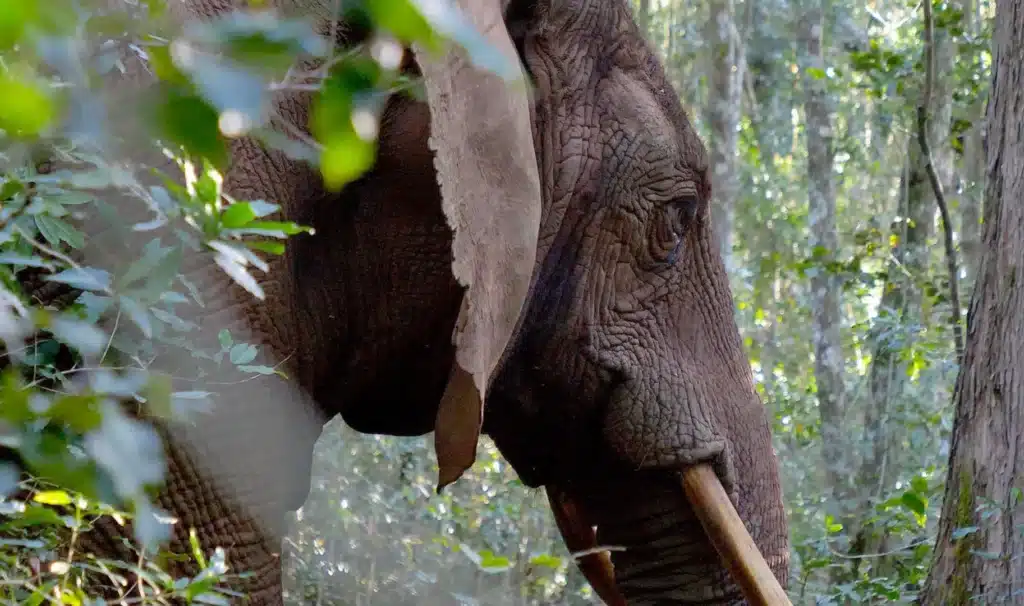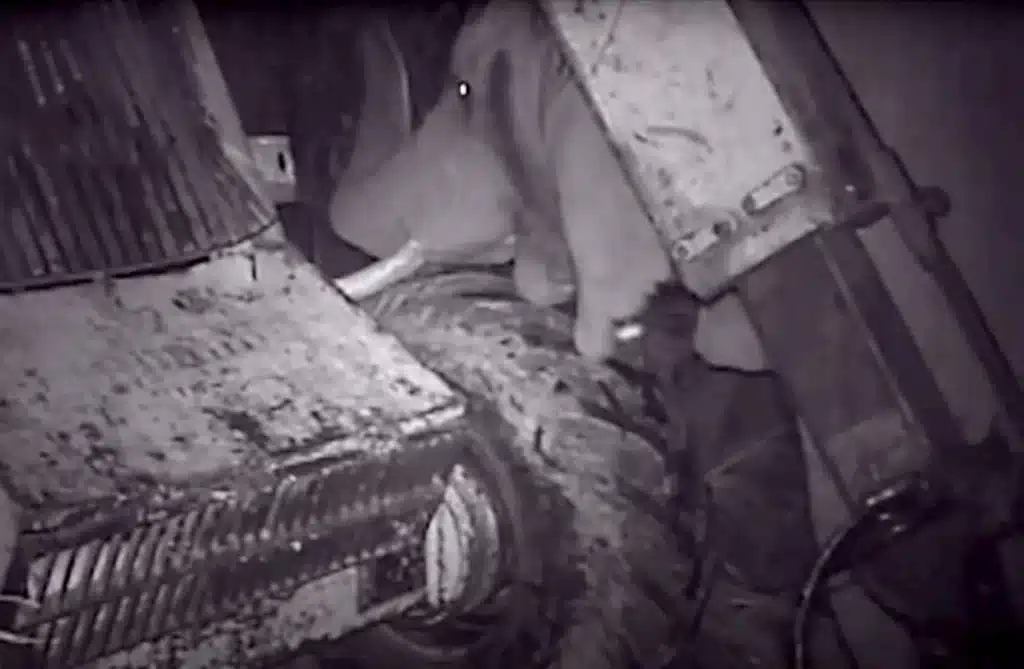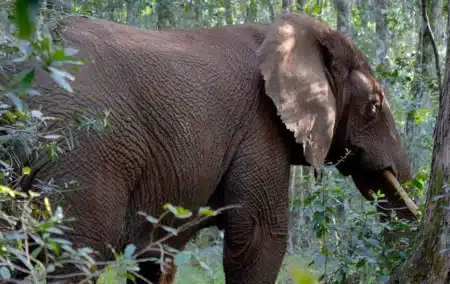The last surviving elephant in the Knysna forests has been lonely for a long time. A small public interest group hopes to change that.
You could cut the tension with a knife as a full house in the hall of the Knysna Angling Club watched veteran wildlife filmmaker Ryan Davy quietly track his way through the dense Knysna forests.
He had spent a total of 12 weeks, in four three-week trips over nearly a year, tracking circles through the largest indigenous old-growth forest in South Africa, in search of its elusive inhabitant: the last surviving Knysna elephant.
When he finally found her, on 19 June 2023, his eyes shone with excitement. Audible gasps rose from the audience watching his success projected onto a large screen.
The elephant had known Davy was there long before he first heard her movements. She chose to show herself. She seemed relaxed and unbothered, posing briefly for Davy before strolling on by and disappearing back into the forest like a ghost.
And what a magnificent animal she was. She appeared to be in excellent condition.

The footage was shown at a public meeting held on 14 March 2024. As a journalist, I always try to remain objective, but in this case, I’m afraid I’m a part of the story. I hosted the meeting and did most of the talking.
Several people, including my editors, asked me to write about it, so here I am, awkwardly reporting on my own talk.
And then there was one
In 2019, SANParks biologist Lizette Moolman co-authored a research paper entitled And Then There Was One: a camera trap survey of the declining population of African Elephants in Knysna, South Africa.
Using a network of trailcams throughout the expanse of the Knysna forests, the researchers had captured over 5 000 elephant images in 149 different events. In 144 of those events, the elephant could be identified, and every single time, it was the same female elephant.
Females by nature travel together in herds, so the chance that another female exists, but was never spotted by the trailcams, is nil. (Technically speaking, that’s not true. Technically speaking, I make the chance 0.5144, which is 4.5 x 10-44, which is not nil.)
The cameras were also close enough together to exclude the possibility that a lone male could maintain a range in between them while never tripping any of the cameras.
This poor elephant really is the last of the legendary Knysna elephants, popularised worldwide by Dalene Matthee’s book Circles in a Forest, in 1984.
When Davy heard this news, he embarked on a mission, not only to capture her on film, but also to find her some company. Elephants are social animals, after all. They’re not meant to be alone.
Conflicting reports
There have been numerous conflicting reports about the identity and number of elephants in the forest over the last 25 years, some of which have been discredited by scientists.
We know that there were at least 11 in 1970. We suspect there were perhaps three or four remaining at the turn of the century. But the last time that any other elephant was seen in the forest was a bull sighted in 2008.
Chances are that the last remaining elephant has been alone for a long time, now.
Tracks show that the elephant has been known to congregate with cattle on private land. There is also documented evidence that she sometimes cosies up to heavy logging equipment for company at night and has lain down to sleep between a logger and a tractor.

The Moolman paper reports that the last remaining elephant was almost always spotted with streaming temporal glands, indicating stress that Moolman believed was likely related to her loneliness. The paper also agrees that lone cows are extremely rare in the wild.
We should be careful not to project human emotions upon animals, but it certainly looks like she’s lonely, and pining.
Herd Instinct
While continuing his search for the elephant, Davy joined up with a retired businessman, Rod Ward Able, an avid outdoorsman who loves riding his mountain bike in the forest, to work on a project to bring more elephants to the Knysna forest.
They were joined by Jarrett Joubert, a qualified nature conservationist at the African Elephant Research Unit (AERU), based at the Knysna Elephant Park (KEP).
They learnt that Ian Withers, the owner of the KEP, had separately made a proposal to SANParks in June 2020 to introduce a small herd of elephants into the forest, and decided to adapt and promote that proposal.
Some eighteen months ago, they recruited me to help with a public meeting they had been planning for early in 2023. We called our group Herd Instinct.
We engaged local landowners, whose farms either form part of the elephant’s range, or adjoin the forest, and they overwhelmingly expressed support for the idea. One respected farmer bluntly said if we don’t do it, he would buy an elephant and do it himself.
We also engaged with SANParks – which initially expressed enthusiasm about the idea – but they asked us to put a public meeting on hold for a few months until they could complete a survey of stakeholders and other internal processes.
These processes had been ongoing since 2017 and were meant to have been completed by 2021. We agreed to postpone our meeting, but a year later, we could wait no longer. The elephant isn’t getting any younger.
Identity
We call the elephant Fiela.
When we saw the initial footage, we were convinced that this was the calf that was reported to have been born in 1989. That calf had been seen in 1990, and her tracks were identified again in 2000.
The images Davy got showed a healthy elephant that we thought could easily be 35.
Several experts, however, insisted that she was closer to 50.
With little evidence to go on, we closely examined photographs from sightings of ‘the Matriarch’ in 1994 and 2008 and compared them to the trailcam photos taken in 2017 and Davy’s photos in 2023.
It became clear that all were of the same elephant, which very likely corresponds to a calf reportedly born in March 1970.
We didn’t like the name Oupoot, since that was the name of the bull elephant in Matthee’s Circles in a Forest. Since this elephant is female, we preferred the name Fiela, from another of Matthee’s books.
So Fiela is likely 54. She could probably still reproduce, since research shows female elephants likely remain fertile until their deaths of old age at 70 or 80. However, her age makes it all the more urgent to find her some company.
Kruger elephants
This isn’t the first attempt to introduce elephants into the Knysna forest. Famously, three young female elephants were rescued from a cull in the Kruger National Park in 1994 and introduced to the Knysna forest.
They did not adapt well at all. They were stressed and traumatised, and quite unaccustomed to the forest environment and the local forage.
The youngest of the three, Fern, died within months from stress-related pneumonia. The remaining two joined up with the Matriarch briefly, before leaving the forest for nearby farmland, where they caused significant damage.
The experiment was finally aborted in 1999, with the capture of the two remaining elephants and their successful removal to Shamwari Game Reserve.
Our proposal differs in important ways from the Kruger elephant attempt, and we believe that these differences will be key to the success of the project.
The proposal
The idea is to introduce three young female elephants, aged between 10 and 15, into the Knysna forest.
The elephants will be donated to the project by the Knysna Elephant Park, and they’ll be relocated from the Plettenberg Bay Game Reserve, where they live at the moment.
The Knysna Elephant Park has extensive experience of rewilding elephants rescued from various crisis situations, having released and introduced 35 elephants to existing herds on numerous private reserves throughout the Eastern and Western Cape.
Unlike the Kruger elephants, the three elephants earmarked for this project have not recently been traumatised or stressed and are fully acclimatised to local conditions and the fynbos and forest diet.
Theirs will be a 90-minute drive down the road, not a major translocation from an entirely different biome.
Although the elephants we’re proposing to introduce have not been trained, they have been habituated to humans and learned from their peers to react to commands given by their elephant guides.
They come to their minders when called. This, too, will prove to be critical to the success of the project.
Boma
Herd Instinct, together with the KEP and AERU, propose to erect a boma and the necessary basic infrastructure for staff and scientists, in an area known to be frequented by the last Knysna elephant. A suitable location has already been identified.
Being habituated elephants, the newly introduced herd will be let out of their boma daily to forage in the forest and called back to their night camp in the evening.
The elephant minders will monitor the elephants from a distance while they are abroad, using GPS radio collars and other non-invasive tracking techniques.
We propose to protect private landowners outside of Fiela’s range by installing virtual fences in selected areas. These use cameras and infrared sensors to alert minders to passing elephants, allowing them to react swiftly to call the elephants back.
We have technology that wasn’t available in 1994. We propose to use it.
This, the fact that the elephants are already used to the local vegetation and diet, and the ability to manage the movements of the introduced elephants, will prevent a recurrence of the Kruger elephant failure.
Aware, but wary
Fiela will most likely become aware of the new elephants immediately and will likely show interest but remain very wary at first.
The time in the night camp will allow Fiela to investigate and possibly even become familiar with the new arrivals on her own terms from outside the fence.
Fiela will soon realise that there is a pattern to the herd’s behaviour and will gradually feel more familiar and comfortable with the new elephants.
Ultimately, the decision whether to accept the new elephants is that of Fiela. Elephants, particularly females, have a social nature and as such are likely to form bonds given time and opportunity. We feel confident that with perseverance and a little patience, there is a very good chance that she will welcome the new arrivals.
Cost implications
The entire proposal comes with no cost implications for SANParks, the Department of Forestry, or local landowners.
KEP will donate the elephants to the project at no cost. The cost of the boma, the staff, the animal transport, the research, and other project expenses will be raised and carried entirely by the KEP.
Neither Herd Instinct nor the KEP expect to profit in any way from this project. We have no commercial interest in the project at all.
This is an honest attempt to assist SANParks based on the KEP’s thirty years of practical experience with elephants in the Knysna environment. It’s about doing the right thing by Fiela.
Should Fiela, after an 18-month trial period, not accept the new arrivals, the project is fully reversible.
In such an event, KEP would undertake to remove the new elephants from the forest, remove all structures associated with the project, and again cover all costs of the reversal.
Future options
If Fiela accepts her new herd, however, there are several options for the future.
The introduced elephants can gradually be released from their boma for longer and longer periods, until they return only by choice, if at all. In due course, the boma can likely be removed entirely.
Another option to consider is the introduction, either temporarily or permanently, of a bull, in the hope that the genetic line of the last Knysna elephant can be continued.
Whether or not to do so will be a matter for SANParks scientists and other experts to determine, but Herd Instinct and the KEP stand ready to assist in any way possible.
SANParks statement
Soon after we finally announced this public meeting, SANParks issued a statement in which it committed to pursuing an evidence-based approach to managing the last Knysna elephant.
We wholeheartedly agree that any interventions must be based on scientific evidence.
We were also delighted to learn that the results of the SANParks study ‘support the introduction of more elephants to the Garden Route elephant range’.
This agrees with the sentiment at the meeting, where everyone who expressed a view was in favour of the Herd Instinct proposal, and nobody indicated opposition.
SANParks no doubt has reservations about the use of habituated elephants and may have suspicions about the commercial interests of the Knysna Elephant Park. There are, of course, other risks and complexities. We believe we can allay those fears and address those difficulties.
As Herd Instinct, we only wish to present a low-risk, fully funded proposal that is ready for expert analysis and rapid implementation.
We are in no way wedded to this proposal. Herd Instinct is willing to adapt the proposal upon the advice of SANParks scientists and other experts. Herd Instinct is also more than willing to support alternative proposals, provided they are feasible, reversible, have a high likelihood of success, and will relieve the loneliness of Fiela as a matter of urgency.
Heritage
The elephants of the indigenous forests are deeply ingrained in Knysna’s culture and heritage. Many locals have grown up with the forest, the timber industry, and the elephants in their blood.
It would be a great shame to watch the last Knysna elephant die alone and lonely.
Human interference caused the decline of the elephant herds that once roamed these forests and fynbos in great numbers. Poor management led to the near-extinction of the remaining herd of 11 that was documented in 1970.
It is time to right, even if only in a small way, these wrongs. One way or another, new elephants need to be introduced to continue the legacy of the Knysna elephants, and soon.
We believe this proposal is the most rapid and least intrusive approach of relieving Fiela’s loneliness.
It will cause the least amount of stress and have the highest assurance of safety, for hikers and bikers, for surrounding landowners, for the rewilded elephants and for Fiela’s own well-being.
Let’s save the last Knysna elephant from her loneliness.
The views of the writer are not necessarily the views of the Daily Friend or the IRR
If you like what you have just read, support the Daily Friend
Fiela, also known as Oupoot, photographed by Ryan Davy on 19 June 2023. Used with permission.

